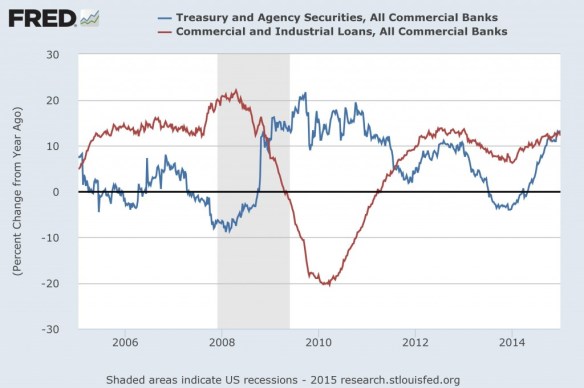Â

Â
For the first time since 2008, banks are rushing into government Treasuries (public) holdings faster than corporate/consumer loans (private). Bank portfolio holdings have been a key component in monitoring the shifts between public and private confidence. These shifts from government securities to private holdings within bank portfolios is an important leading indicator of the rise and fall in confidence. Normally, this will flip to government (public) when we have a recession and private will be on the rise into the peak of the economy. We can see this traditional relationship with the major decline into the bottom of the ECM in 2011.
Look closely now at 2014. Holding of government debt (public) is rising rapidly faster than we have ever seen historically during a non-recessionary economic trend. This is confirming the concentration of capital into public paper for the peak in 2015.75. Typically, this should be declining as you would normally be producing a bubble in some private aspect within the global economy. To see this relationship flip at this point in the cycle is a very serious confirmation that this bubble will be in government paper not private.
Under a normal business cycle model, loans as a rule are more profitable than Treasuries. Consequently, banks traditionally prefer lending to portfolio investments in government bonds. During the mid-2000s, the above chart shows, bank holdings of Treasury and Agency securities fell marginally while the year-on-year growth rate of commercial and industrial loans soared above 20%.

Â
This private to public holdings reversed during the Great Recession which is what we call the Flight-to-Quality. This current return to public holdings growing faster than private for first time since the 2008 crash would normally warn that we are headed into a recession and interest rates would drop with lessor demand and the Fed would lower rates going with the trend trying to “stimulate†a hopeless collapse in confidence to inspire borrowing. In this case, there is no huge collapse in the private holdings, just the public are now exceeding private. This is a reflection more of a bubble in public debt.

